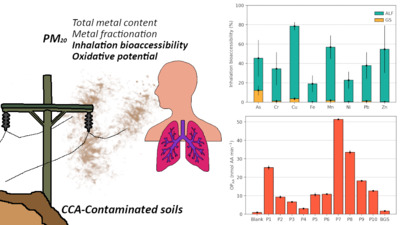Mathieu Gosselin et Gérald J. Zagury
Article de revue (2020)
 Document en libre accès dans PolyPublie Document en libre accès dans PolyPublie |
|
Libre accès au plein texte de ce document Version finale avant publication Conditions d'utilisation: Creative Commons: Attribution-Pas d'utilisation commerciale-Pas de modification (CC BY-NC-ND) Télécharger (504kB) |
|
|
Libre accès au plein texte de ce document Matériel supplémentaire Conditions d'utilisation: Creative Commons: Attribution-Pas d'utilisation commerciale-Pas de modification (CC BY-NC-ND) Télécharger (8kB) |
|
|
Libre accès au plein texte de ce document Matériel supplémentaire Conditions d'utilisation: Creative Commons: Attribution-Pas d'utilisation commerciale-Pas de modification (CC BY-NC-ND) Télécharger (252kB) |
|
![[img]](https://publications.polymtl.ca/43643/14.hassmallThumbnailVersion/2020_Gosselin_Metalloids_inhalation_bioaccessbility_oxidative_potential_Supp3.png)
|
Libre accès au plein texte de ce document Image - Matériel supplémentaire Conditions d'utilisation: Creative Commons: Attribution-Pas d'utilisation commerciale-Pas de modification (CC BY-NC-ND) Télécharger (2MB) |
Abstract
Field-collected chromated copper arsenate (CCA)-contaminated soils and associated particulate matter (PM) were characterized for their total metal(loid)s content (As, Cr, Cu, Fe, Mn, Ni, Pb and Zn) and physicochemical properties. Copper, Ni, Pb and Zn fractionation (using sequential extraction) and inhalation bioaccessibility (using two lung fluids) of trace elements were assessed in PM samples. In Gamble's solution (GS), low average bioaccessibility (up to 12%) was observed for As, Cu, Mn, and Ni. A strong correlation (r = 0.92, p < 0.005, n = 9) between the soluble and exchangeable fraction (F1) and bioaccessibility in GS was observed for Cu. Inhalation bioaccessibility in artificial lysosomal fluid (ALF) was higher for Cu (avg. 78.5 ± 4.2%), Mn (avg. 56.8 ± 12.1%), Zn (avg. 54.8 ± 24.5%) and As (avg. 45.4 ± 18.8%). Strong correlations between inhalation bioaccessibility in ALF and the mobile (i.e. F1+F2) metal fraction were observed for all tested metals (i.e. (Cu (r = 0.95, p < 0.005), Ni (r = 0.79, p < 0.05), Pb (r = 0.92, p < 0.005) and Zn (r = 0.98, p < 0.005)), n = 9). The oxidative potential (OP) of PM was also assessed using an ascorbate (AA) depletion assay (OPAA). Mobile Cu fractions were deemed to be the main factor influencing OPAA ((F1 (r = 0.99, p < 0.005), F2 (r = 0.97, p < 0.005)), n = 9) in PM samples. A strong correlation (r = 0.94, p < 0.005, n = 10) was also observed between Cu bioaccessibility in GS and OPAA.
Mots clés
Inhalation bioaccessibility, Oxidative potential, Particulate matter, Metals and metalloids, Contaminated soils, Chromated copper arsenate.
| Sujet(s): | 1400 Génie minier et minéral > 1401 Génie minier |
|---|---|
| Département: | Département des génies civil, géologique et des mines |
| Organismes subventionnaires: | CRSNG/NSERC |
| Numéro de subvention: | RGPIN-2016-06430 |
| URL de PolyPublie: | https://publications.polymtl.ca/43643/ |
| Titre de la revue: | Chemosphere (vol. 238) |
| Maison d'édition: | Elsevier Ltd |
| DOI: | 10.1016/j.chemosphere.2019.124557 |
| URL officielle: | https://doi.org/10.1016/j.chemosphere.2019.124557 |
| Date du dépôt: | 18 avr. 2023 15:00 |
| Dernière modification: | 27 avr. 2024 12:29 |
| Citer en APA 7: | Gosselin, M., & Zagury, G. J. (2020). Metal(loid)s inhalation bioaccessibility and oxidative potential of particulate matter from chromated copper arsenate (CCA)-contaminated soils. Chemosphere, 238, 124557 (8 pages). https://doi.org/10.1016/j.chemosphere.2019.124557 |
|---|---|
 Statistiques
Statistiques
Total des téléchargements à partir de PolyPublie
Téléchargements par année
Provenance des téléchargements
Dimensions





